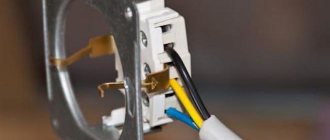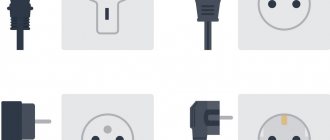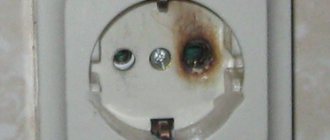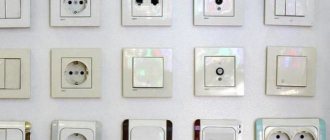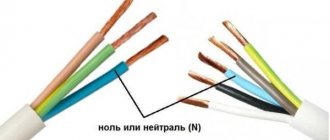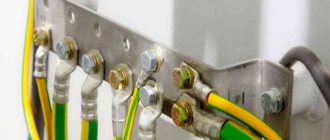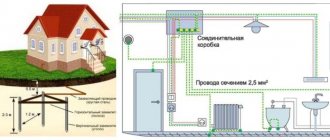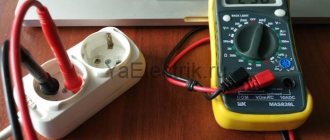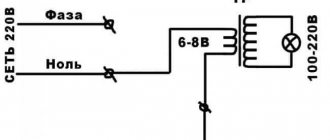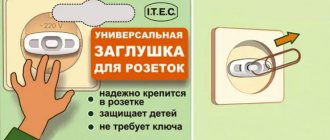Design features
Every house has a grounding loop. Electricity enters an apartment or residential building through a three-wire cable. The cable consists of three wires: ground wire - yellow-green, neutral wire - black or blue, and phase wire - brown or white. In older houses, it is not possible to install a grounded outlet, since a two-core cable is used to supply electricity.
Grounded sockets have an additional contact, which is a metal plate.
The design is made in such a way that the contacts of the neutral and phase wires of the socket enter the socket only after the grounding terminals have touched. This design is made for safety reasons.
This is interesting: Differential circuit breaker
Hazardous work practices
When grounding, you should not resort to simplified methods of this type of protection:
- using a grounding wire;
- grounding through heating system pipes.
In the first case, if all electrical appliances are working properly, the neutral conductor is ready to act as a grounding conductor.
It is worth remembering the purpose of the residual current device.
Grounding is a protection system when any current leakage is converted into a short circuit and triggers a differential circuit breaker or RCD.
If the design is in good working order, the owner of the electrical appliance will, at best, receive a tripping of the protective element due to a short circuit. However, if the grounding wire is damaged in any way, the phase voltage (220 V) will appear on the housing.
In the second case, the pipeline system will work until part of the pipe in one of the apartments in an apartment building is replaced with plastic analogues. Due to the fall out of the metal part of the heating system, the supplied current will endanger both you and your immediate neighbors.
Under no circumstances should gas pipes be used to organize a protective grounding system. Because the electrical potential on the surface can lead to destructive consequences.
To ensure electrical safety, outlets in the house must be connected to a grounding circuit. When organizing such a protection system, you should avoid common mistakes, and entrust the installation of the circuit to an experienced electrician.
Types of sockets with grounding and their features
There are two types of grounded outlets:
- with internal placement;
- with external placement.
The first option is used for hidden wiring. The second is for external wiring. Wooden houses use external wiring and externally placed sockets.
In Russia, type F sockets are common - this is a Euro socket with plates or brackets for grounding and 4.8 mm holes.
Modern residential buildings are designed in such a way that it is possible to connect grounding. The owner of the apartment only needs to distribute the wires correctly and feel safe.
Older houses do not have grounding. But there must be grounding in the electrical panel, which is located on the site of a residential building. In order to find out whether such grounding really exists, you need to contact a service organization and get advice from an electrician. If grounding is provided, then all that remains is to lay the third wire to each socket and thus turn the two-wire wiring into a three-wire one. In this case, a copper wire with a cross-section of at least 2.5 square meters is used as a grounding conductor. mm.
When it is prohibited to connect grounding to sockets
There are a number of rules regarding the safety of electrification of premises. Their violation can mean only one thing - the creation of a situation fraught with electric shock to people.
It is prohibited to connect a hidden wiring socket to grounding in the following cases:
- Damage or rupture of the wire leading to the steel frame buried in the ground.
- The presence of a jumper between the neutral and ground lines.
- Output of the third wire to house communications - water, gas or heating pipes.
Connections can be made only after defects in the electrical wiring have been eliminated.
Why do you need grounding in an apartment?
Grounding is a forced connection of electrical installations and equipment to a grounding device. Essentially, grounding is designed to protect humans (and animals) from the dangerous effects of current when insulation breaks down and voltage is applied to the housing.
Suppose a washing machine is connected to an outlet that does not have a ground. If the cable is damaged, the body of the machine is likely to be energized. If a person touches the body, he will receive an electric shock. Extended current can cause serious injury or even death.
But if the outlet is grounded and the grounding itself is implemented correctly, when touching the body of the washing machine under voltage, a person will receive a shock of minimal value (about 0.0008 A), which he most likely will not feel. The current will flow through the grounding wire to the ground. Therefore, outlets must be grounded in every home .
But the question arises: what conditions must be met for the grounding of outlets to work properly?
- Purchase
Installing wiring in the house: how to choose the right cable?
Is it possible to protect against leakage current
Is it possible to protect against leakage current through the body, which can appear at any moment? The worst thing is that it is impossible to predict such a situation - voltage on the device casing can appear at any second. Water spilled on a coffee maker or meat grinder, vibrations, electrical breakdown of poor-quality insulation, failure of electrical circuit elements - all this is unpredictable and at the same time deadly. There is only one way out - to create a protection system that will be constantly on alert. And such a system exists, and its name is grounding.
Operating principle of protective grounding
To correctly understand the purpose and principle of operation of a grounded socket, you should take a closer look at its connection diagram.
Installing sockets with grounding allows you to ensure a connection between the metal casing of the electrical installation and the grounding circuit. Under normal operating conditions, such a connection does not in any way affect the operation of the electrical network elements; its operational characteristics remain the same as when using an outlet without grounding. However, if the insulation is damaged, grounding ensures that there is no high potential on the housing relative to ground. It also prevents the build-up of static electricity. This is achieved due to the presence of a wired connection with low active resistance between the metal parts of the case and the ground. In this case, when a person touches a grounded electrical installation, electric shock will not occur, since the skin resistance is many times higher than the resistance of the ground loop.
USEFUL INFORMATION: Wi-Fi router into an outlet: repeaters, repeaters
How to choose the right outlet
To choose the right outlet, you need to study and evaluate a number of factors that will affect its reliability and functionality.
You should focus on the following criteria:
- Type of metal. Stainless steel parts have the best characteristics.
- Power. A good option is a two-socket 16 A device.
- Case material. It is better to choose ceramics, which are resistant to heat and corrosion.
- Type. If you install an indoor unit, you can save space. The open method saves effort and time.
When choosing, every little detail matters, including the color and design of the product.
Disadvantages of the ground loop
Despite the obvious advantages that a grounded socket has, its use still has certain disadvantages:
- Lack of monitoring of the insulation condition and automatic shutdown of power in the event of a violation of its integrity. This drawback fully applies to electrical networks that use sockets without grounding.
- The flow of differential current (leakage current) leads to gradual destruction of the insulation at the point of its damage. When using a socket without grounding, as a rule, there is no talk of any leakage current. High potential immediately appears on the body.
- Differential current can lead to heating of the connection points of grounding wires and, as a result, to an increase in their resistance and even the occurrence of fires.
- Relatively high price. The only quality in which sockets without grounding are in a more advantageous position. However, the difference in price is insignificant.
All these shortcomings clearly indicate that in addition to sockets with grounding contacts, the electrical wiring of modern apartments should use devices that provide additional safety for consumers. Such devices include RCDs and differential circuit breakers, which allow you to instantly disconnect a section of the electrical circuit in which the leakage current exceeds permissible values.
This is interesting: What wire to use for wiring: what cross-section, how many cores
Why ground an electrical circuit?
Many ordinary people are stunned by the information that the neutral and grounding conductors in the socket can be connected to the same wire on the floor panel (or the main distribution panel of the house). A logical question arises: why pull the third wire if two of them are still connected to each other?
In practice, the fundamental principle applied here is that everything in nature moves along the path of least resistance from greater to lesser. Water flows from top to bottom, heat is transferred from a hot body to a cold one, and electric current flows to where the resistance of the conductors is less.
If a short circuit occurs in an electrical circuit without grounding, then the mechanism of its action is approximately the following:
- The current strength and voltage in the network increases abruptly tens of times.
- If the wiring is weak, it will burn out.
- If the wiring strand is of sufficient thickness (section) to withstand increased loads, it heats up, causing the insulation to ignite.
- Whether the wiring is burned out or not, if during a short circuit a person touches any metal part of the device, then he receives an electric shock, and its values are an order of magnitude higher than just in a socket. In the first case, this is a short-term shock, and in the second, until the current finds a weak point in the wiring and burns it, after which the circuit opens.
If there is grounding, then everything is not so sad:
- The current and voltage increase, but at the same time they immediately have “where to run” - the grounding wire.
- The natural resistance of the human body is much greater than that of copper, aluminum or steel, so even if a person holds on to the metal parts of the device, the current will simply “pass by” along an easier path. Hence, one of the requirements for grounding wiring is that it should be carried out, if possible, with one solid wire - twists are allowed on the floor panel, on the input circuit breaker, and then one solid core runs through the apartment.
On regular wiring there are automatic switches that trip if the load in the circuit exceeds permissible limits. During normal operation of the circuit, there should be no voltage at all on the grounding wire, so in conjunction with it it is logical to use an RCD that responds to leakage current, which is usually insignificant. As a result, in the event of a short circuit, the current is turned off immediately, and not due to melting of the wiring.
For more information about what happens when there is a short circuit in the circuit, watch this video:
The role of grounding in terms of electrical safety is discussed above, but it also serves to prevent electrical noise that can negatively affect the operation of computers and other delicate devices. Watch this video for more details:
What is grounding
Grounding refers to the intentional connection of an electrical installation or network point to a grounding device. Sockets in private homes, apartments and businesses have long been grounded. Previously, such devices were called “Euro sockets” - the technology originated in Europe.
Sockets sold in stores have three terminals - phase, zero (neutral), ground (three-pole devices). Wiring in new buildings is made of three wires according to safety requirements. Two-wire wiring remains in old apartments and dachas, but it is also being actively replaced by modern ones. The difference between old and new sockets is the presence of a third ground wire.
Grounding purposes in the home
The purpose of grounding is to reduce the risk of short circuits and ensure comfortable living conditions for humans. Each electrical appliance has a housing and insulation of electrical wires; they prevent electric current from harming a person. If the integrity of the insulation is compromised, there is a risk of voltage appearing that can cause an electric shock. Grounding will prevent such consequences.
The advantage of the socket is that the grounding contacts begin to work first, and the current-conducting elements turn on later. If there is a problem with the network, power supply to the product will be interrupted. Installing a product with a grounding contact means protecting electrical appliances from power surges that can damage equipment.
Checking stable operation
The presence of three holes in a socket alone is not a sufficient guarantee of safety. The system will only work if the wiring in the residential premises is built taking into account modern requirements.
To carry out testing activities, you will need an indicator screwdriver and an ampere-volt-ohmmeter.
The verification technology is as follows:
- Unscrew the connector and make sure there are three wires of different colors;
- Carry out a visual inspection of the cores for damage, ensure their integrity and suitability for use;
- If you are unwilling or unable to open the case, you need to use an indicator screwdriver;
- The light bulb should light up only once - at the moment of touching the “phase”;
- If all conditions are met, it is the turn of the ampere-volt-ohmmeter. One probe of the switched-on device is fixed in the “ground” hole, and the second is touched in turn to “zero” and “phase”;
- If the device display shows zeros when connecting “phase” and “ground”, you need to sound the alarm: there is no protection at all.
- It is also a malfunction if two phases are detected immediately.
Installation features
When a person lives in a new apartment, house, the housing is built taking into account safety requirements, the electrical cables in it are three-core. Connecting the outlet will be easy. But if there is no third contact, you will have to ground the wire - you need to contact the management company and invite specialists. Residents of the upper floors will bear lower costs.
How to ground a power outlet: options
In an apartment where grounding is not provided, it can be done in two ways:
- Pull the bus from the home to the switchboard on the landing. This is done with copper wire.
- Establish grounding, replacing grounding with it. By zeroing we mean connecting the ground contact to the zero contact. This connection method can be dangerous.
If there is a distribution box in the apartment, you should connect the cable to it or to the panel, connect the phase and neutral to the device, and at the output route the wires to the places where the sockets are installed.
Location of phase and zero
In order to correctly and safely carry out work on installing a grounded outlet, it is important to determine the location of the phase and zero. Before starting the search, you need to turn off the machines in order to de-energize the line or the entire apartment. Next, using a special screwdriver, phase is revealed (the light bulb or neon indicator is illuminated) and zero (there is no light). There will be a ground wire between them.
By dismantling the old device, you can identify the location of the phase and neutral by color. Coloring the wire will help you not to confuse their location:
- at zero - blue, blue-white;
- at the phase - black, red or brown;
- at grounding - yellow-green.
There is no clear prescription for where the phase and zero will be located - they can be swapped. It is important to correctly secure the ground wire to the top or central terminal, and attach the phase and neutral to the remaining two in any order to close the circuit.
It is prohibited to install a jumper to the grounding terminal from the neutral - this is life-threatening due to the risk of phase voltage reaching the socket block!
Connecting wires: specifics
In high-quality products, the wires are tightly clamped with special terminals and do not fall out, but sometimes you have to disassemble them and tighten the fasteners. There is a reliable way to reduce the work to a minimum.
It is necessary to bend the wires stripped of insulation into rings 0.5 cm in diameter and bring them under the top of the bolts. This way the contacts will heat up slightly, and the contact area between the protective contacts and conductive elements will become maximum.
Place for socket
Before grounding the outlet and installing it, you need to decide on the location of the device. It will depend on the devices intended for use. The device is often placed 30 cm from the baseboard, but individual needs also need to be taken into account.
If you have to damage the wallpaper to install a new socket, you should place it near the baseboard to run cables through it (such a position for the device will be inconvenient). For a medium-sized room, 3-4 nests are enough.
Sockets can be external or internal. The former protrude above the surface of the wall, the latter are “recessed” completely into the wall. This should be taken into account when choosing their location. The easiest way to install products is at the repair stage - this way you can avoid dirt, dust, and inconvenience.
Mounting the socket
Installation of a grounded socket with hidden wiring begins with the installation of a plastic socket box, which must be purchased separately. You also need to check the cross-section of the cable in the wall and the wires in the purchased product - they must be the same! The installation procedure for the device is as follows:
- De-energize the apartment by turning off the machine or unscrewing the plugs.
- Mark on the wall the place for the socket box (glass) with a pencil.
- Make a niche with the required dimensions using a hammer drill.
- Mix a small amount of gypsum (cement, alabaster).
- Fix the plastic cup in the niche with plaster and secure the wiring.
- After 20 minutes, tighten the fastening bolts on the glass.
Next, prepare the cables - they need to be divided into separate cores by 7–10 cm, and the ends must be stripped of insulation by 0.5 cm. Modern sockets are equipped with contacts with special clamps; they are easy to install. Each wire should be connected to the corresponding power wire (according to the diagram).
After connecting the socket with grounding, its working part should be screwed with self-tapping screws to the previously installed glass. Hide the wires in a glass. At the end of the work, screw the lid on. If the device is located next to the baseboard, it is better to immediately buy protective plugs - they will protect the outlet openings from water entering while washing the floor.
Open wiring socket
If you have to ground an open wiring outlet, you need to take its features into account. For overhead-type products, the internal strip has holes for fastening. To position the device evenly, you need to remove the cover, make marks for the dowels and carefully drill holes. Insert 2.5 cm dowels and 5 mm plugs into them.
Connecting the protective conductor and checking it
General rules
Before you connect the ground to the outlet, you should connect it correctly. Therefore, in our article we will describe all stages of organizing protective grounding, starting from the input panel and ending with connection to electrical equipment.
- First of all, it should be remembered that the protective conductor should not contain disconnecting devices in its circuit. Therefore, it is mounted in addition to any automatic machines, switches and fuses.
- Use a green/yellow wire to indicate protective ground. This will greatly facilitate the connection of all devices and eliminate questions about how to determine the grounding in the outlet during repairs.
- The cross-section of the protective grounding wire must be no less than the cross-section of the phase or neutral wire.
- According to clause 3.247 of SNiP 3.05.06-85, series connection of grounding conductors is prohibited. Each new connection must be made with its own conductor.
Laying out protective wires throughout the apartment
Connecting the protective conductor to the socket
If you do not know how to connect the ground to an outlet, then following our step-by-step instructions, you can easily complete this task.
So:
- First of all, remove the voltage from the distribution box from which you will connect the outlet. If other wires pass through this box, then voltage should also be removed from them. It’s better to turn off the entire apartment or house.
- Open the box and identify the phase, neutral and protective wires. If your lighting network is made according to PUE standards, it will not be difficult to do this by color. If this is not the case, then you will have to run around with the voltage indicator.
- The protective wire is connected to the socket contacts, located separately from the two power ones. It may be located differently for different models of outlets, but is usually indicated by a grounding sign or can be determined visually.
- We connect the phase and neutral wires to the power contacts of the socket. Moreover, the order is not important here.
Note! When connecting an electric furnace and some other powerful electrical installations, the order of connection is important. Usually the instructions for connecting them contain a reminder about this. If there are no such references or you are connecting an outlet for public use, then the order does not matter.
- Now all that remains is to connect the wires from the outlet to the corresponding wires in the junction box. After this, insulate and lay them, and you can apply voltage to the outlet.
When you can’t, but really want to
There are quite a few ways to install a grounded outlet, bypassing the provisions of the PUE. All of them are, to a greater or lesser extent, a violation - to use them or not - this decision is made at your own peril and risk, but in any case you need to be aware of the possible consequences. The fact is that many of these methods are used happily ever after, but sooner or later something happens that is why they were banned. As a result, neglect of electrical safety rules endangers the life or health of not only the owner of such wiring, but also other people living with him in the same house.
Zeroing
This is one of the most common ways to ground an outlet if there is no separate PEN conductor. To make a grounding, you need to connect the working zero to the grounding contact - this is done by installing a jumper in the socket itself. The connection diagram for this method of “protection” is based on the fact that even in old wiring, the working neutral conductor is grounded in the distribution transformer. After short-circuiting the zero and grounding, if a phase appears on the device body, a short circuit will occur and the input circuit breaker will turn off the electricity.
Disadvantages of zeroing:
- When a phase “breaks through” the housing, the device, although not for long, is still energized and if at that moment a person touches it, he will receive an electric shock.
- If on the way to the socket the neutral wire in the wiring burns out (a fairly common fault in electrical wiring), then in most cases there will be a phase on the body of the devices. To do this, a single light bulb or power supply of any device that is not turned off is enough. In this case, the circuit breaker does not operate.
Read more about the dangers of zeroing in this video:
Connection to a lightning rod
If there is a lightning rod installed on the roof of the house, and the metal strip that connects it to the grounding passes close to the apartment window, then in this case you can connect to the grounding loop and conduct grounding to all sockets.
An excellent way to solve the problem, as a result of which the apartment will be connected to high-quality grounding. This method has only one drawback - grounding works well until the lightning rod is used for its intended purpose, or more precisely, until lightning strikes it. It is better not to know and not experience from personal experience what voltage will appear on the housings of devices connected to ground.
Grounding through heating pipes or water supply
Another common way to ground an outlet yourself is to strip a piece of water pipe and connect a grounding wire to it. On the one hand, it would seem a logical solution - the pipes in any case have contact with the ground. On the other hand, it is unknown to what extent this contact meets the grounding requirements, and if voltage appears on them, then there is a possibility that the current will not go into the ground, but will hit the person who is holding onto the pipe (washing his face or drawing water from the tap).
An additional disadvantage of this solution is the plastic water supply, which is often laid instead of rusted iron pipes. If the pipes on the fifth floor are metal, and on the third floor they are already plastic, then instead of grounding the pipes will simply be energized.
How to ground an electrical appliance
So, you purchased a washing machine or a gas heating boiler. How to ground them? First of all, you need to find the grounding itself.
Where to find ready-made grounding
As mentioned above, almost all apartment buildings have their own outline . The main distribution board housing and, most importantly, each access distribution board are connected to this circuit. Even the residents of the ninth floor have a circuit literally under the door - a floor-level metal panel with electric meters.
If you look inside such a shield (just look, and don’t crawl around with pliers!), you will probably see a lot of wires bolted directly to the shield body. That's it, grounding! If you connect the casing of the same boiler to such a bolt, then this casing will be reliably protected from the appearance of voltage on it, which means that the operation of the device will be completely safe even if a malfunction occurs in it.
The situation is somewhat worse for owners of private houses, where there may not be a standard circuit. There are two options here - create a contour artificially or use a natural one. You read about the second type above and whether you should connect to it or not is your choice. It’s safer, of course, to make a grounding loop yourself, especially since it’s not at all difficult. But if you still decide to use natural grounding, then this photo will help you connect to it correctly:
Such a connection is only permissible if you are confident in the reliable and long-term electrical connection of the water supply to the ground
How to make grounding yourself
To make a simple outline you will need a massive metal object. This could be an old crumpled barrel, a large thick-walled pan (not enameled), a bicycle frame, scraps of reinforcement welded together, etc. First of all, a couple of meters long current conductor must be securely attached to this object, which will act as a circuit.
To make it, thick iron wire (for example, “wire rod”) with a diameter of 8 mm and above is suitable. You can take long fittings, a pipe, a corner, an iron strip. Using welding or a bolt with a nut, attach the wire to the future circuit. The reliability of the grounding as a whole will depend on the reliability and durability of this connection. To prevent the connection from rusting, paint it with any paint or fill it with bitumen.
Now it's time to do physical labor. Take a shovel and dig a hole of such size that your barrel, frame, or whatever you choose as an outline fits into it. The depth of the hole is at least 1.5 m, and for sandy soil - 2.5 m. Place your circuit in it, and take the conductor out. All that remains is to dig a hole, compact the earth tightly and, for better electrical contact, water it with water, like an ordinary tree. The ground loop is ready. You didn't forget to drill a hole for the bolt on the protruding part of the conductor, did you?
Connecting correctly
Before installation, you need to determine what type of wiring is in the wall. This step requires removing the old outlet, which will expose the number of wires. If there are only two wires, there is no grounding, and we see only the neutral wire, as well as the phase.
For correct connection, all stages of work must be followed:
- Turn off the power supply at the panel;
- Carefully inspect the panel and make sure that the electricity is turned off;
- Next, using a special indicator (the so-called indicator screwdriver), you need to make sure that there is no phase on all 3 wires, or more precisely on their bare parts;
- Unscrew the screw on the body, loosen the tabs, remove the old product;
- If the socket box is in poor condition, it can be cleaned or replaced with a new one;
- Remove the external insulation;
- We clean the ends of the wires.
- Connect the cables to the socket and tighten the screw;
- We connect the third cable to the socket - grounding to the terminal marked as “PE” or with a special sign:
- We fix the case with screws;
- Screw on the housing cover.
